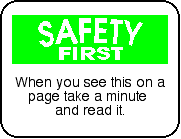|
Safety 101
Accidents are caused by inattention,
taking chances, bad judgement, fatigue, and horseplay. Other
causes are poor instruction (not reading manuals), missing
guards, unsuitable clothing, defective equipment,
insufficient working space and poor lighting.
The first step in preventing personal
injury is to familiarize yourself with any new tool before
using it, read the manual, do a dry run with the machine
unplugged. Only use a tool or machine for its intended
purpose.
Invest in the best and most comfortable
eye protection you can afford, use them
religiously.
A
clean and neat shop is a safe shop, have a garbage can handy, designate
where hand tools are stored, sort nails, screws, and other hardware in
containers. Sweep up at the end of the day, you will feel much better
coming back into a clean shop.
Think an operation through before
beginning it, never put yourself in a compromising
situation, even just for a second.
If it is a two person job don't try to do
it alone, wait until assistance is available.
Stop work when you become tired or
fatigued, never start work if you are under the influence of
medication, alcohol or drugs.
Use hearing protection when performing
noisy operations.
Wear a mask or respirator when necessary,
set up a shop dust collection system if you are continuously
working in dusty conditions.
Label chemicals, use gloves and eye
protection when working with them.
Use gloves to handle material, if you must, but take them off before using any machinery.
Wear proper footwear, sandals or flipflops have no place in a workshop.
Avoid loose fitting clothing when working around machinery.
Clean up any oil spills immediately, use sawdust to soak it up, then sweep up the sawdust.
Safety Glasses
Safety eyewear must conform to a higher
standard of impact resistance than regular eyeglasses, which optical
professionals sometimes call "dress eyewear." This higher standard
applies to both the lenses and the frames of safety glasses and goggles.
Choose safety glasses with a high impact rating, look for the "Z87+" rating on the frame and a "+" mark on the lens.
If you need prescription safety glasses, you must
purchase these from an eye doctor or at an optical store. Again, for
the best protection, choose safety eyewear with a high impact rating.
(The lenses will bear the manufacturer's trademark and a "+." The frame
will be marked "Z87-2" on the inside of the front and temples.)
Your eyesight is precious. Regardless of whether
you need non-prescription safety eyewear or prescription safety glasses,
the investment you make to protect your eyes and vision will pay
dividends as you reduce your risk of a sight-threatening injury.
|

